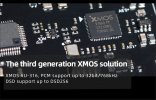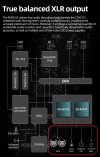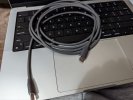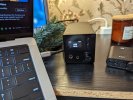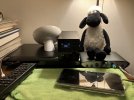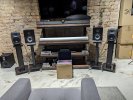I am utterly satisfied with this little DAC.
I got it this week and it's been a great audio experience.
I use it as a secondary listening station in my bedroom, next to my bed. My main audio setup is better than the one in the bedroom, but that's why that one is the main one.
I have the SMSL M300SE receiving input from an compact size Sony DVD player used as a transport via digital coaxial. Also receives input from USB coming from my Pixel Pro phone (USB Audio Player Pro) and my mac M2 and Win11 PC laptops. The M300SE outputs to an iFi ZEN Can via the XLR outputs on its back to the 4.4mm balanced input of the Zen Can (Dual XLR to 4.4mm male cable). The headphones used are Hifiman Ananda and Sundara. I haven't tried yet the HE-R9s since for now I am really enjoying using the M300SE with the Anandas. I am using the balanced 4.4mm headphone output of the Zen Can.
I set the M300SE output volume to Fixed and I am also using the Filter # 5 --for some reason I like that one. I have the Zen Can output level set to 6db. The volume knob is set about the 8 o'clock mark and is loud enough --trying above 8 is just too loud.
The track sources are CDs, Tidal, and a local NAS with a huge FLAC collection.
I mostly listen to vocal and electronic music: pop, rock, R&B, electronica, folk, world and so on. I also listen to orchestral music from time to time. Seldom play hip hop.
The sound is punchy but not tiresome. Softly punchy -as it not smashing you on the face. The sound is also clear and I am able to hear details with clarity on all tracks. I get very good separation of instruments on tracks that merit paying attention to separation. I would call the soundstage as being nicely open, enough to have the sensation of space between instruments and vocals. I am not a bass fiend, so the bass I get is good for me: I get bass lines enough for them to add to the flavor in tracks. MQA is well handled too! In any case, the sound is very enjoyable and makes me want to keep trying all of my available music on this DAC. Before using the M300SE in the bedroom setup I was using an iFi HipDac 2 and a Creative Labs Sound Blaster E5 DAC (this one for its optical input). I like the M300SE's sound much more than those two small and portable DACs.
Again, the M300SE can't beat my main setup, but that was not the intention and for the price of $129 is great considering the variety of its inputs and outputs.
The **only glitch** I experience on the M300SE is this one:
At all times I have two USB cables plugged to the DAC, one for power (using the USB cable that came with the unit) and the other one for data, which I plug to either my phone or the mac and Windows laptops. They are plugged to the USB ports as labeled on the back of the DAC, as per the manual.
When I want to use the USB input I need to first unplug the USB power cable from the M300SE, then the M300SE powers off. Then I plug the data USB cable to the phone or laptop and then the DAC is recognized by the phone/laptop. If I don't unplug the USB power first, then the DAC is not seen/recognized by the phone/laptop. Once the DAC is recognized I plug back the USB power cable. The whole thing takes about 5 to 7 seconds, from unplugging the power USB to the DAC powering on and being recognized. Since I have the power strip right next to my setup and is easily accessible it is not a big deal at all, I just reach for the usb cable, unplug it from its brick (the brick is an old 5V phone charger) and then plug it back because I don't want the DAC to suck power from phone or laptop. I guess I could try not plugging the power back when using phone/laptop and see how long they last with juice.
In any case, mission accomplished: adding the M300SE to my bedroom setup has proven to produce audio sessions that are enjoyable with good sound quality, all for a price that is a bargain, considering the results.

